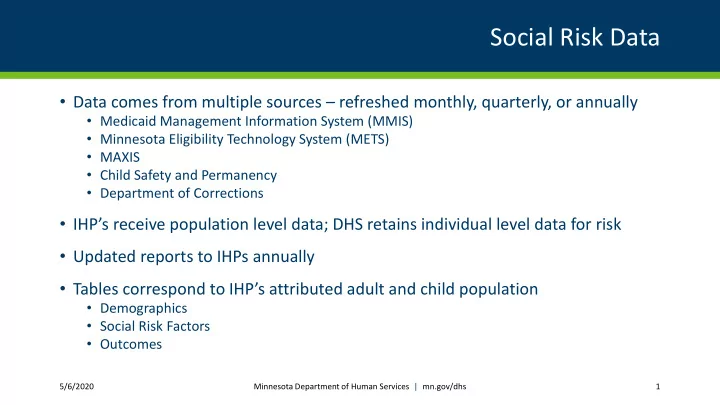

Social Risk Data • Data comes from multiple sources – refreshed monthly, quarterly, or annually • Medicaid Management Information System (MMIS) • Minnesota Eligibility Technology System (METS) • MAXIS • Child Safety and Permanency • Department of Corrections • IHP’s receive population level data; DHS retains individual level data for risk • Updated reports to IHPs annually • Tables correspond to IHP’s attributed adult and child population • Demographics • Social Risk Factors • Outcomes 5/6/2020 Minnesota Department of Human Services | mn.gov/dhs 1
Social Determinants of Health Table 1. Demographics of IHP-attributed Table 3. Prevalence of outcomes among IHP-attributed adult population of adult population of patients. patients. Sample Minnesota Sample Minnesota Demographic IHP Medicaid Outcome IHP Medicaid Male 36.31% 43.53% Table 2. Prevalence of social risk factors among IHP- Type 2 diabetes 8.89% 6.84% attributed adult population of patients. Hispanic immigrant 0.77% 1.05% Asthma 12.59% 9.03% Sample IHP Minnesota Hispanic nonimmigrant 3.24% 3.24% Essential hypertension 19.67% 15.24% Social Risk Factor Medicaid Native American 0.02% 0.02% Heart disease or hospitalized stroke/heart attack 3.33% 2.65% Substance use disorder 14.91% 15.28% immigrant Chronic obstructive pulmonary disease (COPD) 2.76% 2.51% Serious and persistent mental 5.67% 5.01% Asian immigrant 1.81% 2.99% Lung or laryngeal cancer 0.11% 0.13% illness (subset of individuals Black immigrant 5.40% 5.23% HIV 4.18% 6.05% with SMI) White immigrant 1.75% 1.00% Hepatitis C 0.46% 0.83% Serious mental illness (SMI) 30.98% 24.74% Unknown immigrant 4.94% 4.77% Post-traumatic stress disorder (PTSD) 18.05% 13.43% Deep poverty (<=50% FPL) 24.11% 25.24% Native American 1.86% 3.76% Injury due to accident 14.41% 13.13% Homelessness 5.33% 6.61% nonimmigrant Injury due to violence 2.73% 2.47% Past prison incarceration 2.22% 3.21% Asian nonimmigrant 2.98% 3.11% ED visit: Emergent - ED care needed - 30.92% 30.88% Black nonimmigrant 9.31% 9.98% preventable/avoidable White nonimmigrant 48.01% 45.81% ED visit: Emergent - Primary care treatable 47.84% 46.40% Unknown 19.91% 19.04% ED visit: Non-emergent 36.97% 35.22% Nonimmigrant Potentially preventable admission 8.68% 5.45% Immigrant 14.68% 15.05% All-cause readmission (within 30 days of a hospital 1.06% 0.90% Non-English language 5.79% 6.68% discharge) Interpreter Needed 4.15% 5.01% Annual preventive visit (higher rate is better) 52.02% 45.02% Annual dental visit (higher rate is better) 47.89% 38.94% 5/6/2020 Minnesota Department of Human Services | mn.gov/dhs 2
MN-ITS (SFTP) Files File Description Frequency Monthly ~ 11 th Inpatient File Claim extract Monthly ~ 11 th Outpatient & Professional File Claim extract Monthly ~ 11 th Rx File Claim extract Monthly ~ 11 th Demographic File List of attributed members Payment to Charge Ratio File Pay to charge ratios on service category Annual February Enhanced Care Management CMR with additional variables (standard Monthly ~ 22nd Report report available on IHP Portal) Eligibility Span File Detailed eligibility spans on members Monthly ~ 11th 5/6/2020 Minnesota Department of Human Services | mn.gov/dhs 3
SAS Portal for IHPs 5/6/2020 Minnesota Department of Human Services | mn.gov/dhs 4
Care Management Report • Recipient-level • Monthly • Mirrors the Comprehensive Patient Clinical Profile Report available from Johns Hopkins ACG System • Areas addressed and questions this report is able to inform include: • Is this recipient potentially in need of better care coordination ? What were the number and types of providers seen during the observation period? • What are the recipient’s costs for the prior observation period? • Summary utilization statistics for the recipient including outpatient visit counts, Emergency Room visits, and Inpatient Admissions. • Predictive information for resource utilization including cost and likelihood of hospitalization based on the recipient’s prior history and risk indicators. • An indication of whether the recipient’s diagnosis and pharmacy history indicates the presence of chronic conditions . 5/6/2020 Minnesota Department of Human Services | mn.gov/dhs 5
Encounter Alert System 5/6/2020 Minnesota Department of Human Services | mn.gov/dhs 6
Recommend
More recommend